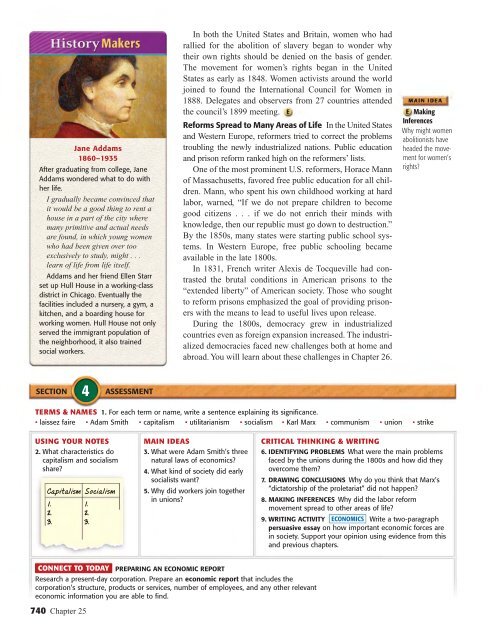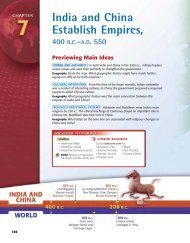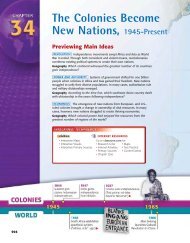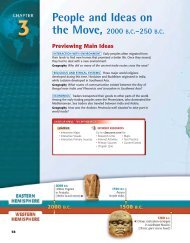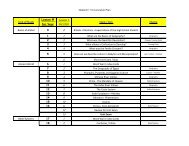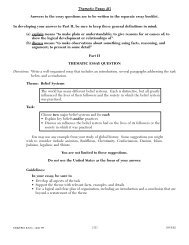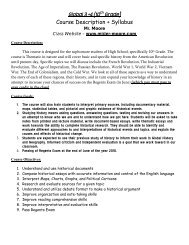The Industrial Revolution, 1700– 1900 Previewing Main Ideas
The Industrial Revolution, 1700– 1900 Previewing Main Ideas
The Industrial Revolution, 1700– 1900 Previewing Main Ideas
You also want an ePaper? Increase the reach of your titles
YUMPU automatically turns print PDFs into web optimized ePapers that Google loves.
Jane Addams<br />
1860–1935<br />
After graduating from college, Jane<br />
Addams wondered what to do with<br />
her life.<br />
I gradually became convinced that<br />
it would be a good thing to rent a<br />
house in a part of the city where<br />
many primitive and actual needs<br />
are found, in which young women<br />
who had been given over too<br />
exclusively to study, might . . .<br />
learn of life from life itself.<br />
Addams and her friend Ellen Starr<br />
set up Hull House in a working-class<br />
district in Chicago. Eventually the<br />
facilities included a nursery, a gym, a<br />
kitchen, and a boarding house for<br />
working women. Hull House not only<br />
served the immigrant population of<br />
the neighborhood, it also trained<br />
social workers.<br />
SECTION 4 ASSESSMENT<br />
740 Chapter 25<br />
In both the United States and Britain, women who had<br />
rallied for the abolition of slavery began to wonder why<br />
their own rights should be denied on the basis of gender.<br />
<strong>The</strong> movement for women’s rights began in the United<br />
States as early as 1848. Women activists around the world<br />
joined to found the International Council for Women in<br />
1888. Delegates and observers from 27 countries attended<br />
the council’s 1899 meeting.<br />
Reforms Spread to Many Areas of Life In the United States<br />
and Western Europe, reformers tried to correct the problems<br />
troubling the newly industrialized nations. Public education<br />
and prison reform ranked high on the reformers’ lists.<br />
One of the most prominent U.S. reformers, Horace Mann<br />
of Massachusetts, favored free public education for all children.<br />
Mann, who spent his own childhood working at hard<br />
labor, warned, “If we do not prepare children to become<br />
good citizens . . . if we do not enrich their minds with<br />
knowledge, then our republic must go down to destruction.”<br />
By the 1850s, many states were starting public school systems.<br />
In Western Europe, free public schooling became<br />
available in the late 1800s.<br />
In 1831, French writer Alexis de Tocqueville had contrasted<br />
the brutal conditions in American prisons to the<br />
“extended liberty” of American society. Those who sought<br />
to reform prisons emphasized the goal of providing prisoners<br />
with the means to lead to useful lives upon release.<br />
During the 1800s, democracy grew in industrialized<br />
countries even as foreign expansion increased. <strong>The</strong> industrialized<br />
democracies faced new challenges both at home and<br />
abroad. You will learn about these challenges in Chapter 26.<br />
TERMS & NAMES 1. For each term or name, write a sentence explaining its significance.<br />
• laissez faire • Adam Smith • capitalism • utilitarianism • socialism • Karl Marx • communism • union • strike<br />
USING YOUR NOTES<br />
2. What characteristics do<br />
capitalism and socialism<br />
share?<br />
Capitalism Socialism<br />
1. 1.<br />
2. 2.<br />
3. 3.<br />
MAIN IDEAS<br />
3. What were Adam Smith’s three<br />
natural laws of economics?<br />
4. What kind of society did early<br />
socialists want?<br />
5. Why did workers join together<br />
in unions?<br />
CONNECT TO TODAY PREPARING AN ECONOMIC REPORT<br />
Research a present-day corporation. Prepare an economic report that includes the<br />
corporation’s structure, products or services, number of employees, and any other relevant<br />
economic information you are able to find.<br />
Making<br />
Inferences<br />
Why might women<br />
abolitionists have<br />
headed the movement<br />
for women’s<br />
rights?<br />
CRITICAL THINKING & WRITING<br />
6. IDENTIFYING PROBLEMS What were the main problems<br />
faced by the unions during the 1800s and how did they<br />
overcome them?<br />
7. DRAWING CONCLUSIONS Why do you think that Marx’s<br />
“dictatorship of the proletariat” did not happen?<br />
8. MAKING INFERENCES Why did the labor reform<br />
movement spread to other areas of life?<br />
9. WRITING ACTIVITY ECONOMICS Write a two-paragraph<br />
persuasive essay on how important economic forces are<br />
in society. Support your opinion using evidence from this<br />
and previous chapters.


